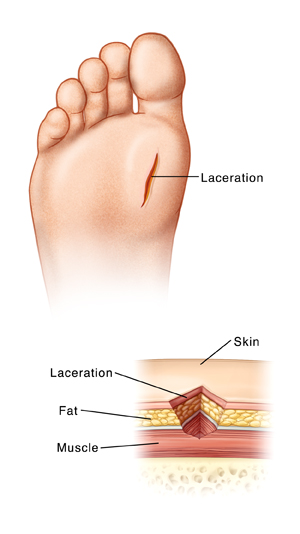Foot Laceration: All Closures
A laceration is a cut through the skin. Deep cuts may require stitches. Minor cuts may be treated with surgical tape closures or skin glue.
X-rays may be done if something may have entered the skin through the cut, such as glass or rocks. You may also need a tetanus shot if you are not up-to-date on this vaccine and the object that caused the cut may lead to tetanus.

Home care
-
Follow all instructions for taking any prescribed medicines.
-
Your healthcare provider may prescribe an antibiotic. This is to help prevent infection. Take the medicine every day until it is gone even if you feel better, unless you are told by your provider to stop it. You should not have any left over.
-
Your healthcare provider may prescribe medicines for pain. Take the medicine as directed.
-
Follow the healthcare provider’s instructions on how to care for the cut. You may also be given instructions for keeping weight off of the area to allow the injury to heal.
-
Keep the wound clean and dry. Don't get the wound wet until you are told it is OK to do so. If the area gets wet, gently pat it dry with a clean cloth. Replace the wet bandage with a dry one.
-
To help prevent infection, wash your hands with soap and water before and after caring for the wound.
-
Caring for stitches: Once you no longer need to keep the stitches dry, clean the wound daily. First, remove the bandage. Then wash the area gently with soap and warm water, or as directed by the healthcare provider. Use a wet cotton swab to loosen and remove any blood or crust that forms. After cleaning, apply a thin layer of antibiotic ointment if advised. Then put on a new bandage unless you are told not to.
-
Caring for skin glue: Don’t put liquid, ointment, or cream on the wound while the glue is in place. Avoid activities that cause heavy sweating. Protect the wound from sunlight. Don't soak the wound for 7 to 10 days. This includes no tub baths, swimming, or hot tubs. Don't scratch, rub, or pick at the adhesive film. Don't place tape directly over the film. The glue should peel off within 5 to 10 days.
-
Caring for surgical tape: Keep the area dry. If it gets wet, blot it dry with a clean towel. Surgical tape usually falls off within 7 to 10 days. If it has not fallen off after 10 days, you can take it off yourself. Put mineral oil or petroleum jelly on a cotton ball and gently rub the tape until it is removed.
-
Once you are told that you can get the wound wet, you may shower as usual, but don't soak the wound in water. This means no tub baths or swimming.
-
Check the wound daily for signs of infection, which are listed below. Even with proper treatment, a wound infection may sometimes occur.
-
After the wound has healed, apply sunscreen to the area to help minimize scarring.
Follow-up care
Follow up with your healthcare provider as advised. Return to have stitches or staples removed as directed. If X-rays were taken, contact your healthcare provider for the results.
When to seek medical advice
Call your healthcare provider right away if any of these occur:
-
A small amount of wound bleeding not controlled by direct pressure. If there is a large amount of bleeding that can't be controlled, call 911.
-
Signs of infection, including increasing pain in the wound, increasing wound redness or swelling, or pus or bad odor coming from the wound
-
Fever of 100.4°F (38.ºC) or higher, chills, or as directed by your healthcare provider
-
Stitches coming apart or falling out or surgical tape falling off before 7 days
-
Wound edges reopening
-
Wound changing colors, other than normal bruising colors
-
Numbness or weakness in the affected foot
-
Decreased movement of the foot or toes
-
Lots of itching or skin blistering from skin glue
Online Medical Reviewer:
Eric Perez MD
Online Medical Reviewer:
Ronald Karlin MD
Online Medical Reviewer:
Tara Novick BSN MSN
Date Last Reviewed:
12/1/2022
© 2000-2024 The StayWell Company, LLC. All rights reserved. This information is not intended as a substitute for professional medical care. Always follow your healthcare professional's instructions.